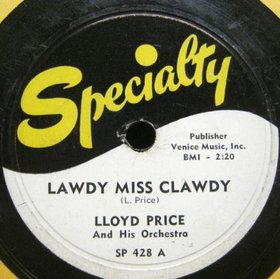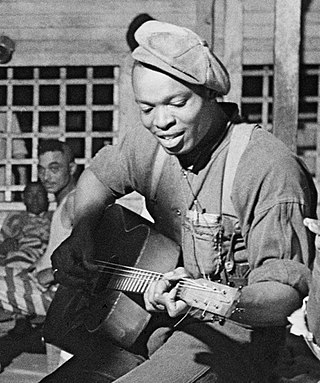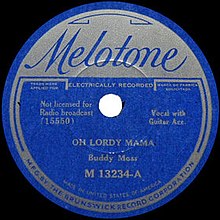
Lizzie Douglas, better known as Memphis Minnie, was a blues guitarist, vocalist, and songwriter whose recording career lasted for over three decades. She recorded around 200 songs, some of the best known being "When the Levee Breaks", "Me and My Chauffeur Blues", "Bumble Bee" and "Nothing in Rambling".
James "Kokomo" Arnold was an American blues musician. A left-handed slide guitarist, his intense style of playing and rapid-fire vocal delivery set him apart from his contemporaries. He got his nickname in 1934 after releasing "Old Original Kokomo Blues" for Decca Records, a cover version of Scrapper Blackwell's blues song about the city of Kokomo, Indiana.

"Kind Hearted Woman Blues" is a blues song recorded on November 23, 1936, in San Antonio, Texas, by the American Delta bluesman Robert Johnson. The song was originally released on 78 rpm format as Vocalion 03416 and ARC 7-03-56. Johnson performed the song in the key of A, and recorded two takes, the first of which contains his only recorded guitar solo. Both takes were used for different pressings of both the Vocalion issue and the ARC issue. The first take (SA-2580-1) can be found on many compilation albums, including the first one, King of the Delta Blues Singers (1961). Take 2 (SA-2580-2) can be heard on the later compilation Robert Johnson, The Complete Recordings (1990).
"Blues in the Night" is a popular blues song which has become a pop standard and is generally considered to be part of the Great American Songbook. The music was written by Harold Arlen, the lyrics by Johnny Mercer, for a 1941 film begun with the working title Hot Nocturne, but finally released as Blues in the Night. The song is sung in the film by William Gillespie.

Steppenwolf Live is primarily a collection of recordings from a single concert early in 1970 at the Santa Monica Civic Auditorium by Steppenwolf staged in support of their 1969 album Monster. Released in April 1970 by Dunhill Records, it contains Steppenwolf's well-known hits: "Born to Be Wild", "Magic Carpet Ride" and "The Pusher", as well as most of the songs from Monster, including three previous top 40 hits, as well as the top 40 hit "Hey Lawdy Mama" from this album.

Birth of the Beatles is a 1979 American biographical film, produced by Dick Clark Productions and directed by Richard Marquand. The film was released into cinemas worldwide, except in the United States, where it was shown as a TV film on ABC. The film focuses on the early history of the Beatles. It was released nine years after the announced break-up of the Beatles themselves, and is the only Beatles biopic to be made while John Lennon was still alive. Pete Best, the Beatles' original drummer, served as a technical advisor for the production.
Admirl Amos Easton, better known by the stage name Bumble Bee Slim, was an American Piedmont blues singer and guitarist.

"Night Time Is the Right Time" or "The Right Time" is a rhythm and blues song recorded by American musician Nappy Brown in 1957. It draws on earlier blues songs and has inspired popular versions, including those by Ray Charles, Rufus and Carla, and James Brown, which reached the record charts. Creedence Clearwater Revival recorded a version of the song on their 1969 album, Green River. The Animals also included a version of the song on their debut album "The Animals," released in 1964.

"Sweet Home Chicago" is a blues standard first recorded by Robert Johnson in 1936. Although he is often credited as the songwriter, several songs have been identified as precedents. The song has become a popular anthem for the city of Chicago despite ambiguity in Johnson's original lyrics. Numerous artists have interpreted the song in a variety of styles.

"Lawdy Miss Clawdy" is a song by New Orleans singer-songwriter Lloyd Price that "grandly introduced The New Orleans Sound". It was first recorded by Price in 1952 with Fats Domino and Dave Bartholomew during his first session for Art Rupe and Specialty Records. The song became one of the biggest selling R&B records of 1952 and crossed over to other audiences. "Lawdy Miss Clawdy" inspired many songs and has been recorded by a variety of artists.
"Motherless Child Blues" is the name of two distinct traditional blues songs. They are different melodically and lyrically. One was first popularized by Robert "Barbecue Bob" Hicks, the other by Elvie Thomas.
Georgia White was an American blues singer, most prolific in the 1930s and 1940s.

"Worried Life Blues" is a blues standard and one of the most recorded blues songs of all time. Originally recorded by Big Maceo Merriweather in 1941, "Worried Life Blues" was an early blues hit and Maceo's most recognized song. An earlier song inspired it and several artists have had record chart successes with their interpretations of the song.

Eugene "Buddy" Moss was an American blues musician. He is one of two influential Piedmont blues guitarists to record in the period between Blind Blake's final sessions in 1932 and Blind Boy Fuller's debut in 1935. A younger contemporary of Blind Willie McTell, Curley Weaver and Barbecue Bob, Moss was part of a coterie of Atlanta bluesmen. He was among the few of his era whose careers were reinvigorated by the blues revival of the 1960s and 1970s.
Charlie Segar was an American blues pianist and occasional singer, who is best known for being the first to record the blues standard, "Key to the Highway" (1940). Originally from Pensacola, Florida, Segar has been dubbed the "Keyboard Wizard Supreme". He relocated to Chicago, where he made recordings with other blues artists, such as Bumble Bee Slim and Memphis Minnie, as well as being the featured artist.
"Milk Cow Blues" is a blues song written and originally recorded by Kokomo Arnold in September 1934. In 1935 and 1936, he recorded four sequels designated "Milk Cow Blues No. 2" through No. 5. The song made Arnold a star, and was widely adapted by artists in the blues, Western swing and rock idioms.
"Sugar Mama" or "Sugar Mama Blues" is a blues standard. Called a "tautly powerful slow blues" by music journalist Charles Shaar Murray, it has been recorded by numerous artists, including early Chicago bluesmen Tampa Red, Sonny Boy Williamson I, and Tommy McClennan. John Lee Hooker and Howlin' Wolf later adapted "Sugar Mama" for electric blues and rock group Led Zeppelin reworked it during early recording sessions.
"Early in the Morning" is a blues song that was recorded by Sonny Boy Williamson I in 1937. Identified as one of his most successful and influential tunes, it was inspired by earlier blues songs. "Early in the Morning" has been recorded by various musicians, including Junior Wells, who made it part of his repertoire.

June Richmond was an American jazz singer and actor.
Frank "Springback" James was an American blues and boogie-woogie pianist, singer, and songwriter. He recorded eighteen tracks released by four record labels between 1934 and 1938, as well as possibly providing accompaniment to several other blues musicians. Details of his life are sketchy, and some of his recording activity has been subject to historical guesswork, rather than hard evidence.










